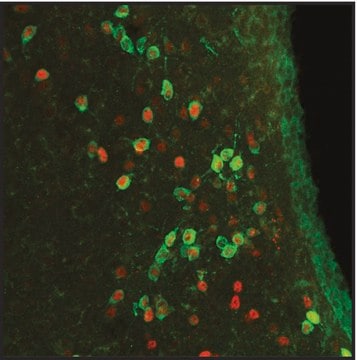추천 제품
생물학적 소스
mouse
Quality Level
결합
unconjugated
항체 형태
purified immunoglobulin
항체 생산 유형
primary antibodies
클론
FMS338, monoclonal
형태
buffered aqueous solution
분자량
antigen 40-45 kDa
종 반응성
human, mouse, rat, canine
포장
antibody small pack of 25 μL
기술
immunocytochemistry: suitable
indirect ELISA: suitable
microarray: suitable
western blot: 0.25-0.5 μg/mL using total cell extract of mouse myoblast C2 cells
동형
IgG2b
UniProt 수납 번호
배송 상태
dry ice
저장 온도
−20°C
타겟 번역 후 변형
unmodified
유전자 정보
human ... ACTR3(10096)
mouse ... Actr3(74117)
rat ... Actr3(81732)
일반 설명
Monoclonal Anti-ARP3 (mouse IgG2b isotype) is derived from the hybridoma FMS338 produced by the fusion of mouse myeloma cells (NS1 cells) and splenocytes from BALB/c mice immunized with recombinant human ARP3. Arp3 is mapped to human chromosome 2q14.1.
면역원
recombinant human ARP3.
애플리케이션
Monoclonal Anti-ARP3 antibody produced in mouse has been used in:
- enzyme linked immunosorbent assay (ELISA)
- immunocytochemistry
- immunoblotting
- immunoprecipitation
- immunofluorescence
- immunohistochemistry
생화학적/생리학적 작용
The ARP2/3 complex consists of seven distinct proteins (Arp2 and Arp3, p41-Arc, p34-Arc, p21-Arc, p20-Arc, and p16-Arc) that modulate polymerization of cellular actin filaments. ARP3 regulates actin nucleation, and is involved in directing the movement of Listeria monocytogenes in infected host cells. Monoclonal Anti-ARP3 antibody binds to human, canine, rat, and mouse ARP3.
The actin-related protein-2/3 (ARP2/3) is part of Wiskott-Aldrich Syndrome protein (WASP) signaling in mediating polymerization state of actin filaments. It has been found that ARP2/3 complex and its activator spinocerebellar ataxia, autosomal recessive 2 (Scar2) are involved in Golgi polarization in NIH 3T3 cells. However in primary astrocytes, Golgi polarization involves neither actin cytoskeleton or Arp2/3 complex nor any WASP-family of proteins. In a different model, it was found that the ARP2/3 complex was necessary for neutrophil chemotaxis and phagocytosis. By genetic and loss of function studies, it was demonstrated that Scar2 is the major regulator of the ARP2/3 complex rather than the WASP family of proteins, the latter having more restricted roles in specific cellular events.
물리적 형태
Solution in 0.01 M phosphate buffered saline, pH 7.4, containing 15 mM sodium azide.
면책조항
Unless otherwise stated in our catalog or other company documentation accompanying the product(s), our products are intended for research use only and are not to be used for any other purpose, which includes but is not limited to, unauthorized commercial uses, in vitro diagnostic uses, ex vivo or in vivo therapeutic uses or any type of consumption or application to humans or animals.
Not finding the right product?
Try our 제품 선택기 도구.
Storage Class Code
10 - Combustible liquids
WGK
WGK 2
Flash Point (°F)
Not applicable
Flash Point (°C)
Not applicable
시험 성적서(COA)
제품의 로트/배치 번호를 입력하여 시험 성적서(COA)을 검색하십시오. 로트 및 배치 번호는 제품 라벨에 있는 ‘로트’ 또는 ‘배치’라는 용어 뒤에서 찾을 수 있습니다.
Genome-wide association study suggested the PTPRD polymorphisms were associated with weight gain effects of atypical antipsychotic medications
Yu H, et al.
Schizophrenia Bulletin, 42(3) (2015)
Environmental toxicants perturb human Sertoli cell adhesive function via changes in F-actin organization mediated by actin regulatory proteins
Xiao X, et al.
Human Reproduction, 29(6), 1279-1291 (2014)
Identification of the p16-Arc subunit of the Arp 2/3 complex as a substrate of MAPK-activated protein kinase 2 by proteomic analysis
Singh S, et al.
The Journal of biological chemistry, 278(38), 36410-36417 (2003)
Arp2/3 and VASP are essential for fear memory formation in lateral amygdala
Basu S, et al.
eNeuro, 3, 1279-1291 (2016)
Paxillin phosphorylation controls invadopodia/podosomes spatiotemporal organization
Badowski C, et al.
Molecular Biology of the Cell, 19(2), 633-645 (2008)
자사의 과학자팀은 생명 과학, 재료 과학, 화학 합성, 크로마토그래피, 분석 및 기타 많은 영역을 포함한 모든 과학 분야에 경험이 있습니다..
고객지원팀으로 연락바랍니다.







